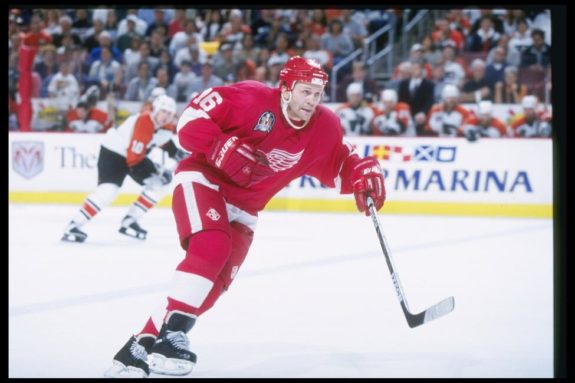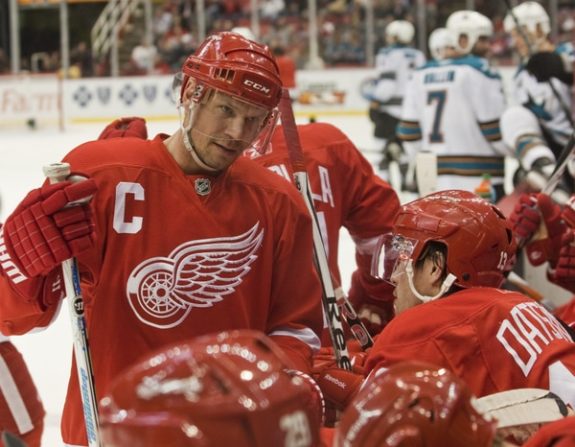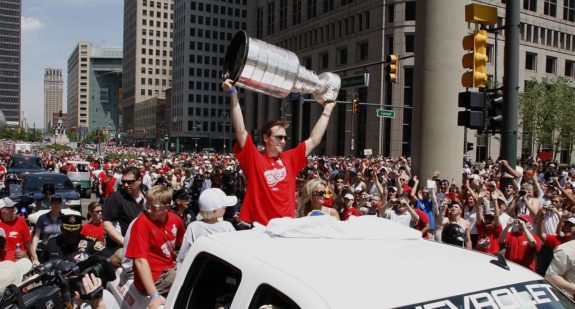
 Tony Wolak
The Hockey Writers
Tony Wolak
The Hockey Writers
37
Reads
0
Comments
Detroit Red Wings: A Tribute to Nicklas Lidstrom
When the Detroit Red Wings drafted Nicklas Lidstrom as part of their historic 1989 draft class, he did not come into their consideration as a consensus can’t miss prospect—he was a skinny third-round pick who needed a lot of muscle in order to make the NHL. The Red Wings believed Lidstrom was good enough to consider him a hidden gem, but surely they had no idea that he would go on to become the greatest defenseman of his generation.
Early Mentors
When Lidstrom entered the league in 1991, he had the benefit of a great defensive coach in Dave Lewis overseeing his development. His offensive game was there—60 points in 80 games—but Lidstrom still had a lot to learn as he adapted to the NHL.

In addition to Lewis, Lidstrom also studied under the tutelage of Paul Coffey, Mark Howe, and his first roommate, Brad McCrimmon. When Hall of Fame coach Scotty Bowman took over as head coach of the Red Wings after countless winning seasons in Montreal and Pittsburgh, Lidstrom’s game elevated even more. The collective knowledge gained from these coaches and players formed the base of Lidstrom’s unrivaled intelligence on the ice.
Related: The Best NHL Defensemen Ever
The Spotlight
When the Red Wings traded Coffey prior to the 1996-97 season, they did so knowing that Lidstrom was ready to be “the guy” on the Detroit blue line. Whether he played with Mathieu Dandenault, Jamie Pushor, Larry Murphy, or Vladimir Konstantinov, the Red Wings coaching staff could trust Lidstrom to shut down opponents’ top lines and contribute offensively. In the 1997 Stanley Cup Final, Lidstrom combined with Konstantinov to shut down Philadelphia Flyers’ famed “Legion of Doom” line en route to winning the Cup.

The following year, the tandem of Lidstrom and Murphy shut down the Phoenix Coyotes, St. Louis Blues, Dallas Stars, and Washington Capitals, leading the Red Wings to a second straight Stanley Cup. The acquisition of Murphy prior to the Red Wings’ 1997 Cup run also furthered Lidstrom’s development. He taught the young defenseman that preservation—both mentally and physically—was key to long-term success in the NHL, something a 26-year old would likely not prioritize.
Even after bringing in Chris Chelios, Ulf Samuelsson, and Steve Duchesne over the next few years, Lidstrom clearly stood out as the Red Wings’ best all-around defenseman and the rest of the NHL started to take notice. It was not unlikely for Lidstrom to play 30-plus minutes a night, even with other great defensemen on the roster.
The Norris Era
As the top defenseman for one the top teams in the NHL, Lidstrom was finally recognized as the best defender in the league when he captured his first Norris Trophy in 2001. This was no fluke. Lidstrom would go on to win six more Norris Trophies, two more Stanley Cups, and a Conn Smythe Trophy before the end of his career. Only two other defensemen dominated the NHL in such a sustained manner—Bobby Orr and Doug Harvey. Lidstrom and Harvey have won the Norris seven times each, sitting second behind Orr’s eight Norris Trophies.
After the NHL resumed play following the 2004-05 Lockout, the game changed for most defensemen. Some could not adapt to the new rules that outlawed the clutch and grab tactics used to shut down opposing offenses. Lidstrom, however, thrived. This was because Lidstrom never played with an overly physical nature. He just outsmarted his opponents and could see plays developing way before anyone else could. Positioning was key to success in the post-Lockout NHL. It was also Lidstrom’s strongest skill.
Captaincy
When fellow Detroit legend Steve Yzerman retired following the 2005-06 season, the choice was clear who would carry on his legacy as captain of the Red Wings. It was an obvious decision when Yzerman was named captain in 1986. It was just as obvious when the Red Wings named Lidstrom captain in 2006.

The Lidstrom Era could not have started off any better. While collecting two more Norris Trophies, Lidstrom led the Red Wings to a Western Conference Final appearance in 2007, a Stanley Cup in 2008, and another Stanley Cup Final appearance in 2009. His Stanley Cup win in 2008 marked the first time in NHL history that a European-born and -trained captain hoisted the Stanley Cup for his team.
Mentoring the Next Generation of Red Wings
By the time the Red Wings won the Stanley Cup in 2008, Lidstrom was 37 and already had a Hall-of-Fame resume. But like Obi-Won Kenobi and Eminem, the young padawan eventually became the mentor.
While continuing to be Detroit’s top defenseman, Lidstrom also took the Red Wings’ young defensemen under his wing and mentored them the same way Coffey, Howe, and McCrimmon did early in his career. Niklas Kronwall, Kyle Quincey, Jonathan Ericsson, and Jakub Kindl all learned a great deal from Lidstrom (plus Chelios and Brian Rafalski) when they were first starting out with the Red Wings.
Even at age 40, Lidstrom could still dominate the NHL. He collected his seventh and final Norris Trophy following the 2010-11 season. Lidstrom also recorded a hat trick that year against the St. Louis Blues.
Related: Top 5 Nicklas Lidstrom Moments
Lidstrom’s Legacy
After two decades of dominance, Lidstrom retired following the 2011-12 season. In 2015, he was immortalized in the NHL Hall of Fame, alongside former teammate Sergei Fedorov, Chris Pronger, Phil Housley, Angela Ruggiero, Bill Hay, and Peter Karmanos Jr.
Looking back, it’s not a stretch to Lidstrom as the best defenseman of his era, the Detroit Red Wings franchise, and possibly all time. His play in transition is the model of all NHL teams today. Lidstrom’s leadership on and off the ice has influenced countless Red Wings and Swedish Olympic teammates.

Lidstrom finished his career with four Stanley Cups, a Conn Smythe Trophy, 20 playoff appearances (which is more than 12 NHL franchises), seven Norris Trophies, 12 All-Star Game appearances, and an Olympic Gold Medal. He had 264 goals and 878 assists over his 1564-game career.
Most of all, Lidstrom was the perfect role model for young Red Wings teammates and younger hockey players watching him play. His gentlemanly play, leadership, positive attitude, and sense of community gave hockey players of all ages the ideal superstar to look up to.
His flaws were rare—he had one fight in his career (and received the instigator penalty). Additionally, he has been in only one fender bender—and that was because best friend Tomas Holmstrom said it was clear when it wasn’t. However, in the defensive zone and on the attack, Lidstrom executed the game of hockey to perfection. Adding in his tremendous personal traits, there’s no surprise that this Hall-of-Famer was nicknamed The Perfect Human.
The post Detroit Red Wings: A Tribute to Nicklas Lidstrom appeared first on The Hockey Writers.
Popular Articles

















































 Blackhawks Chicago
Blackhawks Chicago Panthers Florida
Panthers Florida Penguins Pittsburgh
Penguins Pittsburgh Rangers New York
Rangers New York Avalanche Colorado
Avalanche Colorado Kings Los Angeles
Kings Los Angeles Maple Leafs Toronto
Maple Leafs Toronto Bruins Boston
Bruins Boston Capitals Washington
Capitals Washington Flames Calgary
Flames Calgary Oilers Edmonton
Oilers Edmonton Golden Knights Vegas
Golden Knights Vegas Flyers Philadelphia
Flyers Philadelphia Senators Ottawa
Senators Ottawa Lightning Tampa Bay
Lightning Tampa Bay Islanders New York
Islanders New York Sabres Buffalo
Sabres Buffalo Red Wings Detroit
Red Wings Detroit Devils New Jersey
Devils New Jersey Hurricanes Carolina
Hurricanes Carolina Stars Dallas
Stars Dallas Jets Winnipeg
Jets Winnipeg Blue Jackets Columbus
Blue Jackets Columbus Predators Nashville
Predators Nashville Wild Minnesota
Wild Minnesota Blues St. Louis
Blues St. Louis Mammoth Utah
Mammoth Utah Sharks San Jose
Sharks San Jose Ducks Anaheim
Ducks Anaheim Canucks Vancouver
Canucks Vancouver






